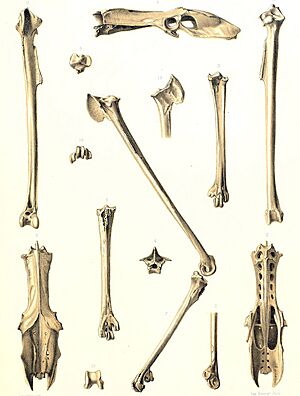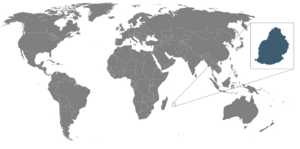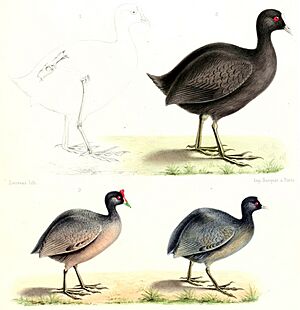Mascarene coot facts for kids
Quick facts for kids Mascarene coot |
|
|---|---|
 |
|
| First known subfossils, 1867 | |
| Conservation status | |
| Scientific classification | |
| Genus: |
Fulica
|
| Species: |
newtonii
|
 |
|
| Location of Mauritius, where subfossils of this species have been found | |
The Mascarene coot (Fulica newtonii) was a type of bird called a coot. It used to live on the Mascarene islands of Mauritius and Réunion. Scientists first found its subfossil bones in a swamp called Mare aux Songes on Mauritius. Later, they also found bones on Réunion, confirming it lived there too. For a long time, people thought old reports from Mauritius were about common moorhens. But it seems moorhens only came to the island after the Mascarene coot had already disappeared.
What the Mascarene Coot Looked Like

The Mascarene coot was a large bird. It was about 45 centimeters (18 inches) long. This made it look like a very big Eurasian coot.
Even though it could fly, it wasn't very good at it. If it felt threatened, it would rather dive underwater to escape. Coots are known for diving, and this bird was especially good at it. It was also very strong and could have easily flown between the islands. This explains why the same type of coot lived on both Mauritius and Réunion.
A traveler named Sieur Dubois described the bird in 1674. He said they were "Waterhens which are as large as fowls. They are always black, and have a large white crest on the head." Scientists think the Mascarene coot might have come from the red-knobbed coot. It's not clear if the Mascarene coot had the small red knobs on its head like the red-knobbed coot, or if Dubois just didn't notice them.
Why the Mascarene Coot Disappeared
The Mascarene coot is now extinct, meaning it no longer exists. Many birds on the Mascarene islands faced problems from new animals like cats. But the main reason the Mascarene coot disappeared was too much hunting.
In 1667, a person named François Martin wrote about hunters killing off the coots on Réunion. Even though people said the bird didn't taste very good, they still hunted them. Martin wrote that a river basin that was once full of water-hens had none left just two years later.
The situation was similar on Mauritius. In 1693, Leguat was the last person to write about these birds. He said they were "already rare." Besides hunting, people building settlements and destroying the marshland where the coots lived also played a big part in their extinction. After the Mascarene coot disappeared, another type of bird, the Eurasian Moorhen, moved to the islands.


